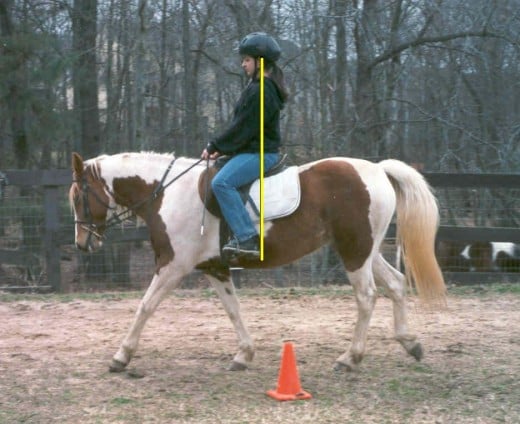Balance Seat Horsemanship
What keeps you from falling off your horse? No, it's NOT the saddle horn! It is balance. Sounds to simple to be true? Read on, and you will see that it really is simple.
Yes, it is true. The key to "not falling off Ole Paint" is keeping your balance. How do you do that? Well, it is as easy as standing with your two feet on the ground. And that is where it all starts, with your feet.
Let's do an experiment. Stand up. Now, put both feet in front of your body, just an half inch. That's right, BOTH feet, at the same time, forward. Oops, did I say make sure you're standing on a soft surface?
Because, if you did what I asked, you are now most likely lying on the floor.
Okay, let's try a different approach. Put both feet behind your body. No, no, no fair! You can't lean forward! Aha! If you did that one without cheating, you are now lying flat on your face!
What I hope you can learn from this exercise is that unless your feet are UNDER your BODY, you will lose your balance and fall. The same holds true when you are mounted on your horse. Your feet must be in line with your body, in order for you to maintain a balanced position on the horse.
Anyone who has read a manual on horsemanship knows the prescribed position goes like this: sit in the middle of your saddle so that if you drop a plumb line from your ear, it will make a straight line from ear, to elbow, through the hip and down the back of your heel. You may have also been told that your knee must be in line with your toe. There are many ways to say the same thing. Sally Swift talks about the rider's building blocks in her book, Centered Riding, Helen Crabtree in her book, Saddleseat Equitation, told her riders to point their knees toward the ground. All of these instructions are aimed at the same thing, BALANCE, and to be balanced you must have your feet under your body.
But, when you are on top of your horse, it is sometimes difficult to know where your feet are. Having an instructor or helper on the ground constantly telling you to adjust your foot is one way to learn proper position. But, if you ride alone there is another exercise that will teach your body to stay in a balance position. Simply stand up in your stirrups. If you can stay standing, without grabbing hold of the reins or saddle horn, you are balanced. But, if you plop right down in the saddle you need to make an adjustment in foot position.
Take Ms. Crabtree's advice and point your knees toward the ground and try again. If you feel like you are going to fall over your horse's neck, you have your feet to far back. Roll your knee and thigh in toward the saddle to gain the proper amount of "feel". When your feet find the right placement, standing in the stirrups will be just as easy as standing on the ground. Practice this exercise at least five minutes per practice session, until you can ride at any gait while standing in your stirrups. Soon your muscles will remember the position and it will become a good habit.
Now that you have your feet in the correct position you must sit up straight. Another tip from Crabtree's book is to imagine that you are pulling your ribs up out of your waistband. This will place your body over your feet and cause you to sit ‘tall in the saddle." Now, roll your shoulders up and back, which opens your chest and allows your lungs to open and fill with air when you breathe. Hunching or pulling your shoulders in will tightened your back muscle and also causes shallow breathing.
The third point to remember is your head position. To stay in balance you must keep your head in line with your body. Remember the line dropping from the ear to the heel. Well, if your head is to far forward the line changes and you lose your balance, even if the feet are placed correctly.
But maintaining the proper head position is also easy. Just focus your eyes ahead of you. This comes in handy, because you can see where you are going! Keeping your eyes focused ahead, rather than down, insures the head does not pull the upper body forward. The human head is heavy, fifteen or more pounds. When you look down, the neck bends and causes the weight of your head to jut out in front of your body. Then the whole upper body leans ahead of the feet, and you are out of balance, again!
Whether you ride saddleseat, over fences, or rodeo broncos this rule of balance never changes. Keep your eyes up and your feet under your body, and no matter what your horse does, your chances of staying on Ole Paint are very good.









